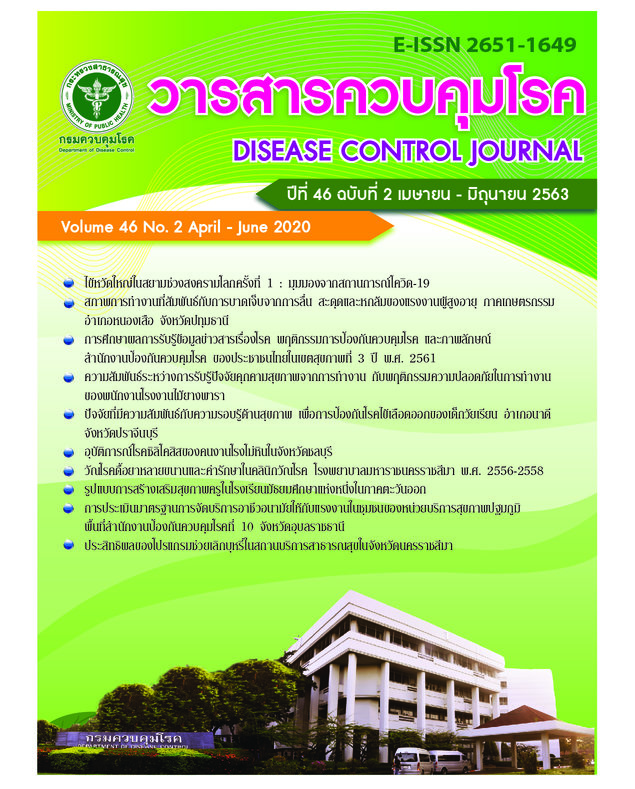An evaluation of perception of information on diseases, Disease prevention and control behavior and public image of Office of Disease Prevention and Control Region 3 among Thai people in Health Zone 3, 2018
DOI:
https://doi.org/10.14456/dcj.2020.13Keywords:
study, perceptio, information, behavior, imageAbstract
This research aimed to study (1) perception of information on diseases, access to and sources of such information, satisfaction level with such information, knowledge and behaviors related to disease prevention and control; (2) the factors related to knowledge and behaviors with respect disease prevention and control; and (3) public image of the Office of Disease Prevention and Control Region 3, Nakhon Sawan Province (ODPC 3) among Thai people in 2018. This study was a field survey. The sample consisting of 1,200 persons from all provinces in Health Zone 3 was randomly chosen using multiple steps. The data was collected using questionnaires and analyzed by descriptive statistics, Chi-square test, and Person’s correlation coefficient. The results indicated that most respondents (1) had overall perception of information (98.8%), and high level of perception (67.3%); the top 3 sources of information were public health staff (97.4%), television and cable TV (97%), and village health volunteers (96.1%); satisfaction with information on diseases and disease prevention and control behavior at a high level (94.7%); high level of good knowledge (76.7%); and found to have the behaviors that are suitable for disease prevention and control at a high level (82.3%). (2) The gender, age, education, and occupation significantly correlated with knowledge and disease prevention behaviors (p<0.05); and (3) public image of ODPC 3 had received positive opinion at a high level of 92.8%. The results of this study suggested that national health agencies should step up a campaign to publicize knowledge and appropriate disease prevention behaviors on television, especially about common cold and cardiovascular disease. In the meantime, regional health agencies should take advantage of personal media (health personnel and health volunteers) that have the potential for effective risk communications by assigning key messages that are appropriate to the target group and the local context of the area.
Downloads
References
Risk Communication and Health Behavior Development Group, Office of Disease Prevention and Control Region 3, Nakhon Sawan. Measurements of risk communication and behavior development. Nakhonsawan: Office of Disease Prevention and Control Region 3, Nakhon Sawan; 2019. (in Thai)
Pawan V, Ponrachom C, Aungjareon R, Siriwat S, Kammooncorn R, Wangkahart A, et al. An evaluation of perception of information on diseases and health hazards, disease prevention and control behaviors, and public image of the Department of Disease Control among Thai people during 2017. Nonthaburi: Department of Disease Control; 2017. (in Thai)
Pawan V, Ponrachom C, Chumkasornkulkit P, Sriboonthip N, Chaipong A. An evaluation of perception of information on diseases and health hazards, disease prevention and control behaviors, and public image of the Department of Disease Control among Thai people during 2018. Nonthaburi: Department of Disease Control; 2018. (in Thai)
Thanpraseartsuk S, Mahotan K, Siripanumas P, Prompanjai P. Strategic Plan for Department of Disease Control 2016-2020. Workshop on enhancing the efficiency in advancing the 20-year strategic framework for the development of national disease and health threat prevention and control strategy, reform implementation phase (2017-2021); 2019 May 1-2; Classic Camio Ayuthaya Hotel. Nonthaburi: Planning Division, Department of Diseases Control; 2017. (in Thai)
Faculty of Public Health, Mahidol University. Process for establishing and maintaining health literacy for sustainable development, development of human resource, and health literacy research for sustainable development. 16th National Public Health Conference: “Health Literacy for Sustainable Development Goal: Development Dimensions.”; 2018 May 31 - Jun 1; Faculty of Public Health, Mahidol University. Bangkok: Faculty of Public Health, Mahidol Universit; 2018. (in Thai)
Narasaswat D, Klamthap A. An evaluation of perception of information on diseases and health hazards, disease prevention and control behaviors, and public image of the Office of Disease Prevention and Control among Thai people in Health Zone 3 during 2017. Nakhon Sawan: Office of Disease Prevention and Control Region 3, Nakhon Sawan; 2017. (in Thai)
Department of Diseases Control. Guidelines for public health risk communications. Nonthaburi: Department of Disease Control; 2017. (in Thai)
Maslow A. Maslow’s Hierarchy of Needs [Internet]. New York. McGraw-Hill; 1943 [cited 2019 April 1]. Available from: http://www.researchhistory.org/2012/06/16/maslows-hierarchy-of-needs
Green W, Kreuter W, Deeds G, Partridge B. Health education planning a diagnostic approach. Califonia: Mayfield; 1980.
Mattawangkur C, Ploykaw P, Thawalsereewatana A, Sithiart A, Noysiriwatana T. Factors associated with preventive behavior and disease control of dengue hemorrhagic fever among people in the responsible area of Sai-See Subdistrict Health Promoting Hospital, Samut Sakhon Province. Journal of Nursing, Siam University [Internet]. 2017 [2019 Apr 5];18:34-48. Available from: https://he01.tci-thaijo.org/index.php/nursingsiamjournal/ article/view/140187/103952 (in Thai)
Downloads
Published
How to Cite
Issue
Section
License
Articles published in the Disease Control Journal are considered as academic work, research or analysis of the personal opinion of the authors, not the opinion of the Thailand Department of Disease Control or editorial team. The authors must be responsible for their articles.






